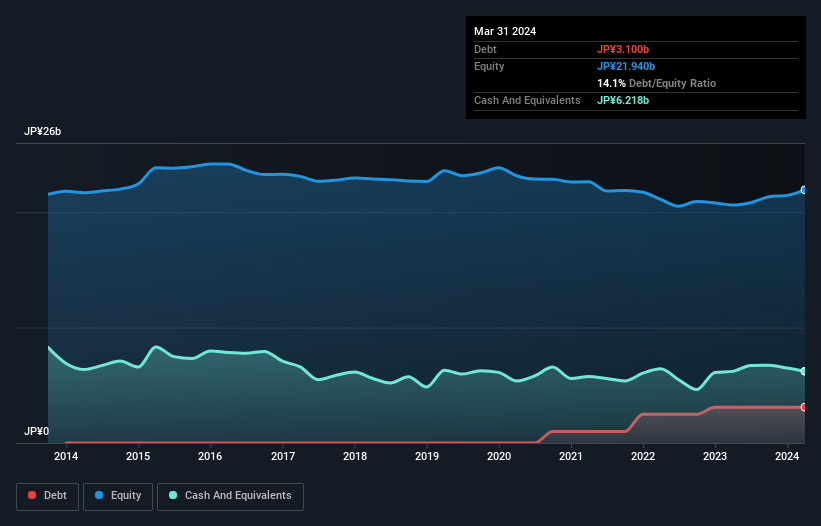- Japan
- /
- Construction
- /
- TSE:1914
Does Japan Foundation Engineering (TSE:1914) Have A Healthy Balance Sheet?

Legendary fund manager Li Lu (who Charlie Munger backed) once said, 'The biggest investment risk is not the volatility of prices, but whether you will suffer a permanent loss of capital.' So it seems the smart money knows that debt - which is usually involved in bankruptcies - is a very important factor, when you assess how risky a company is. Importantly, Japan Foundation Engineering Co., Ltd. (TSE:1914) does carry debt. But is this debt a concern to shareholders?
When Is Debt A Problem?
Generally speaking, debt only becomes a real problem when a company can't easily pay it off, either by raising capital or with its own cash flow. If things get really bad, the lenders can take control of the business. However, a more frequent (but still costly) occurrence is where a company must issue shares at bargain-basement prices, permanently diluting shareholders, just to shore up its balance sheet. Of course, debt can be an important tool in businesses, particularly capital heavy businesses. The first thing to do when considering how much debt a business uses is to look at its cash and debt together.
See our latest analysis for Japan Foundation Engineering
What Is Japan Foundation Engineering's Net Debt?
The chart below, which you can click on for greater detail, shows that Japan Foundation Engineering had JP¥3.10b in debt in March 2024; about the same as the year before. However, it does have JP¥6.22b in cash offsetting this, leading to net cash of JP¥3.12b.

How Healthy Is Japan Foundation Engineering's Balance Sheet?
Zooming in on the latest balance sheet data, we can see that Japan Foundation Engineering had liabilities of JP¥9.94b due within 12 months and liabilities of JP¥962.0m due beyond that. Offsetting these obligations, it had cash of JP¥6.22b as well as receivables valued at JP¥7.76b due within 12 months. So it can boast JP¥3.08b more liquid assets than total liabilities.
This surplus strongly suggests that Japan Foundation Engineering has a rock-solid balance sheet (and the debt is of no concern whatsoever). On this view, lenders should feel as safe as the beloved of a black-belt karate master. Succinctly put, Japan Foundation Engineering boasts net cash, so it's fair to say it does not have a heavy debt load!
Another good sign is that Japan Foundation Engineering has been able to increase its EBIT by 30% in twelve months, making it easier to pay down debt. There's no doubt that we learn most about debt from the balance sheet. But you can't view debt in total isolation; since Japan Foundation Engineering will need earnings to service that debt. So if you're keen to discover more about its earnings, it might be worth checking out this graph of its long term earnings trend.
But our final consideration is also important, because a company cannot pay debt with paper profits; it needs cold hard cash. While Japan Foundation Engineering has net cash on its balance sheet, it's still worth taking a look at its ability to convert earnings before interest and tax (EBIT) to free cash flow, to help us understand how quickly it is building (or eroding) that cash balance. Over the last three years, Japan Foundation Engineering reported free cash flow worth 13% of its EBIT, which is really quite low. For us, cash conversion that low sparks a little paranoia about is ability to extinguish debt.
Summing Up
While it is always sensible to investigate a company's debt, in this case Japan Foundation Engineering has JP¥3.12b in net cash and a decent-looking balance sheet. And we liked the look of last year's 30% year-on-year EBIT growth. So we don't think Japan Foundation Engineering's use of debt is risky. The balance sheet is clearly the area to focus on when you are analysing debt. But ultimately, every company can contain risks that exist outside of the balance sheet. For example, we've discovered 2 warning signs for Japan Foundation Engineering that you should be aware of before investing here.
At the end of the day, it's often better to focus on companies that are free from net debt. You can access our special list of such companies (all with a track record of profit growth). It's free.
New: Manage All Your Stock Portfolios in One Place
We've created the ultimate portfolio companion for stock investors, and it's free.
• Connect an unlimited number of Portfolios and see your total in one currency
• Be alerted to new Warning Signs or Risks via email or mobile
• Track the Fair Value of your stocks
Have feedback on this article? Concerned about the content? Get in touch with us directly. Alternatively, email editorial-team (at) simplywallst.com.
This article by Simply Wall St is general in nature. We provide commentary based on historical data and analyst forecasts only using an unbiased methodology and our articles are not intended to be financial advice. It does not constitute a recommendation to buy or sell any stock, and does not take account of your objectives, or your financial situation. We aim to bring you long-term focused analysis driven by fundamental data. Note that our analysis may not factor in the latest price-sensitive company announcements or qualitative material. Simply Wall St has no position in any stocks mentioned.
Have feedback on this article? Concerned about the content? Get in touch with us directly. Alternatively, email editorial-team@simplywallst.com
About TSE:1914
Japan Foundation Engineering
Provides various construction services in Japan.
Solid track record with adequate balance sheet and pays a dividend.
Market Insights
Community Narratives



